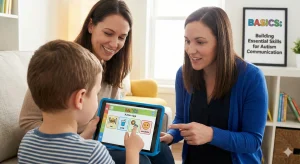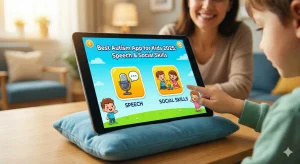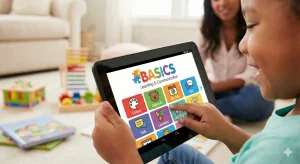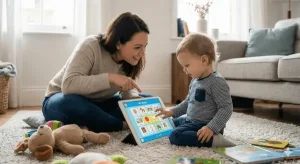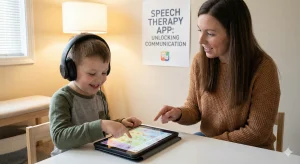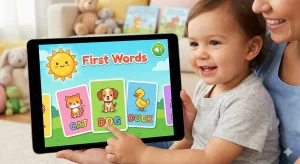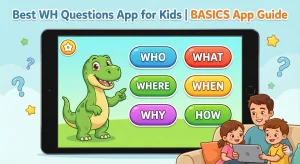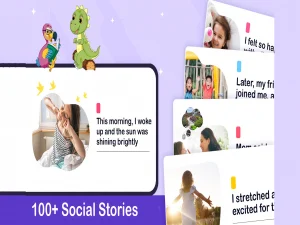Benefits of Social Stories for Children with Autism and ADHD
By Wellness Hub
Last Updated: January 21, 2025
Social stories are transformative tools for children with Autism Spectrum Disorder (ASD) and Attention Deficit Hyperactivity Disorder (ADHD). Created to help kids understand social norms and cues, these structured narratives improve communication and behavior. At Wellness Hub, we’re dedicated to providing resources that support these effective strategies, ensuring every child can navigate social challenges with greater ease. Let’s explore how social stories can make a significant difference.
Struggling to explain daily routines to your child? Download these Social Stories tailored for kids with ADHD and Autism and make communication easier! – Get the Stories Now
What Are Social Stories?
Social stories are special tools designed to help children with Autism Spectrum Disorder (ASD) and Attention Deficit Hyperactivity Disorder (ADHD) understand social rules. Created by Carol Gray in 1991, these stories explain social situations in a straightforward way, highlighting what to expect and how to act.
Children with autism and ADHD often find social cues confusing. Social stories break down these cues into simple steps, making it easier for kids to learn appropriate social behaviors. For example, a story might show how to take turns during playtime or how to greet someone politely.
Key Benefits of Social Stories for Autism
Social stories are valuable autism therapy tools that help improve communication and social understanding in children with autism. Here’s how they make a difference:
1. Enhancing Communication Skills
- Verbal Communication: Social stories provide clear examples of everyday interactions, such as asking for a toy or greeting a friend, which teach children the appropriate verbal responses in various social situations.
- Non-Verbal Communication: These stories often include descriptions of facial expressions, body language, and eye contact, helping children understand and mimic non-verbal cues.
2. Improving Social Understanding
- Recognizing Social Cues: Social stories explain social situations by detailing what to do and why. For instance, a story might show why sharing toys is important, linking the action of sharing to making friends feel happy.
- Reacting Appropriately: By outlining the consequences of social interactions, social stories help children see the impact of their behavior on others, promoting empathy and appropriate responses.
Ease your child’s anxiety with visual guides designed for Autism and ADHD. Download our Social Stories today and make their world more predictable. – Click to Download
Advantages of Social Stories in ADHD Management
Social stories are powerful tools for managing Attention Deficit Hyperactivity Disorder (ADHD). They offer structured narratives that help enhance focus and regulate behavior. Here are the key advantages:
1. Fostering Attention and Concentration
- Structured Learning: Social stories break down social situations into manageable parts, helping children with ADHD focus on one concept at a time.
- Engagement: By using engaging and relatable content, social stories maintain the attention of children with ADHD, especially in settings with multiple distractions.
2. Promoting Behavioral Regulation
- Impulse Control: These stories teach children the consequences of their actions, helping them learn to pause and consider the effects before acting.
- Emotional Management: Social stories illustrate appropriate emotional responses to everyday situations, aiding children in understanding and regulating their emotions.
3. Crafting Effective Social Stories
Social stories are not just a storytelling tool but a form of story-based intervention that can significantly impact children with ADHD and autism. Creating a social story that captivates and educates requires understanding the elements that make them successful and knowing how to integrate them effectively into daily routines. Here’s how you can craft social stories that truly resonate and provide benefits.
4. Elements of a Successful Social Story
Creating effective social stories involves several key components:
- Clear and Concise Language: Use simple, direct language that the child can easily understand. Avoid metaphors or ambiguous phrases that could confuse the reader.
- Specific Details: Include specific information about the situation you are addressing, such as who is involved, what they are doing, and where it is happening. This helps the child visualize and comprehend the scenario better.
- Positive Descriptions: Focus on positive behavior outcomes. For example, instead of saying “don’t run,” you might say “walk inside the classroom.”
- Visual Aids: Incorporate pictures or symbols to support the text. Visuals can help reinforce the message and make the story more engaging and understandable for visual learners.
- Consistent Structure: Keep a consistent format that includes a beginning that sets the scene, a middle that shows the action, and an end that provides closure or resolution.
Tips for Parents and Educators
Integrating social stories effectively into a child’s routine can maximize their benefits:
- Routine Integration: Introduce social stories during regular daily activities or just before specific events that the story addresses. This helps the child apply the lessons learned directly to real-life situations.
- Repetition: Regularly revisit the same social stories to reinforce the behaviors and lessons. Repetition helps children with ADHD and autism to internalize the expected actions and outcomes.
- Interactive Engagement: Encourage the child to ask questions and discuss the story. You can ask questions like, “What do you think he should do next?” to make the session interactive.
- Feedback Incorporation: Use feedback from the child’s responses to adapt the stories over time. This ensures they remain relevant and effective as the child’s understanding and circumstances evolve.
- Collaborative Story-Making: Involve children in creating their social stories. This can be a powerful way to ensure the stories resonate with them and address their specific challenges and experiences.
Conclusion
Social stories are powerful tools that help children with autism and ADHD navigate social challenges by enhancing communication and improving behavior. These stories break down complex interactions into easy steps, making social cues clearer and easier to manage. Explore the full potential of social stories with Wellness Hub. We offer a wide range of resources to support parents and educators. Visit our Social Stories Resources page for customizable templates and practical guides. Help your child or students thrive in their social world with our expertly designed tools.
Frequently Asked Questions:
1. What are social stories?
Social stories are short descriptions of a particular situation, event, or activity, which include specific information about what to expect in that situation and why.
2. How can social stories help my child with autism?
Social stories help children with autism understand social norms, recognize cues, and learn appropriate responses for various interactions.
3. Are social stories effective for children with ADHD?
Yes, social stories can help children with ADHD by improving their attention, helping them focus on tasks, and teaching them how to manage their behaviors in social settings.
4. What should a good social story include?
A good social story should be clear, concise, and detailed with visual aids to help the child understand the context and the expected behaviors.
5. How often should I use social stories with my child?
It’s beneficial to use social stories regularly, especially before specific events or situations that your child finds challenging.
6. Can I create my own social stories?
Yes, parents and educators can create customized social stories tailored to their child’s needs and situations they commonly face.
7. What age are social stories suitable for?
Social stories are versatile and can be used for children of various ages, from preschoolers to older children, depending on their developmental level.
8. Where can I find examples of social stories?
You can find examples of social stories on educational websites, in books, or through platforms like Wellness Hub that offer resources for parents and educators.
9. How do social stories improve communication in children with autism?
Social stories improve communication by explicitly describing social interactions and appropriate responses, which helps children with autism better understand and engage in social communication.
10. Can social stories be used in schools?
Yes, social stories are often used in educational settings to help students with autism or ADHD understand and navigate social dynamics in the classroom.
About the Author:
Shravanaveena Gajula
M.Sc ., Speech and Language Pathology (5+ years of experience)
Shravanaveena Gajula is a dedicated Audiologist and Speech-Language Pathologist with a BASLP and an M.Sc in Speech and Language Pathology. With experience spanning multiple settings, including Wellness Hub and Ashray Akruti, Veena specializes in a wide range of disorders from developmental issues in children to speech and language assessments in adults. Her expertise includes parent counseling, managing speech sound and fluency disorders, and creating individualized therapy programs. Veena is also PROMPT certified and an author of several insightful blogs on speech and language pathology, aiming to educate and assist caregivers in supporting their loved ones.
Book your Free Consultation Today
Parent/Caregiver Info:
Client’s Details:
* Error Message

